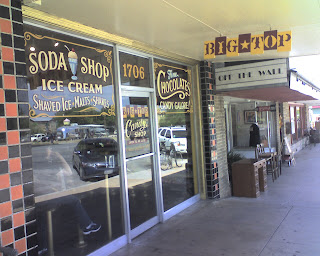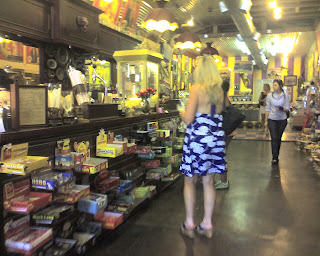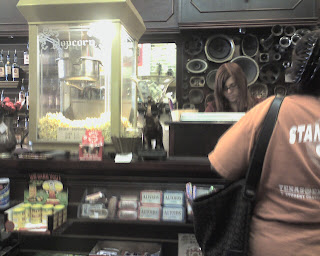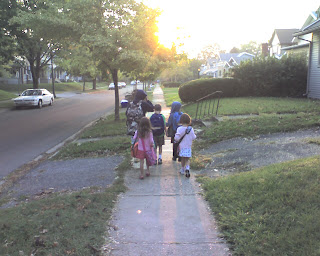Wednesday, November 5, 2008
The 21st Century Begins Now.
Thursday, October 2, 2008
The Power of Digital Signage
One thing to look out for is digital signage. It holds great potential for retailers to provide much more infomation in stores where you are trying to make an informed decision, it can also provide fun, entertaining atmosphere, too.
Every client I have worked with in the last several years is very interested in figuring this out. Digital signage holds great potential to make the shopping experience more robust. Consumers can get the right amount of information they want when they want it. Retailer and brand marketer can integrate out-of-store media and there is significant opportunity to reduce operational costs and create new effeciencies by centrally controling content.
Look at what Sears and Kmart are doing in test stores in Richmond Illinois and Cincinatti, Ohio. They have installed several approaches to integrate digital signage, media content and their websites. Also, and this may seem obvious, look at what Nintendo is doing in NYC. Their NintendoWorld store not only provides lots of robust gaming experiences, but the screens, when idle, rotate brand and product messages.
There seems to be a gap, though, between the hardware people and the store people. I think we in the retail design industry need to go to school on time-based graphic communication, put it in the hands of the talented designers and see what they can do with it.
Monday, September 22, 2008
Independents in Austin
I had an hour before I had to head to the airport.
Whenever I’m in Austin I try to spend as much time as possible on South Congress. My favorite hotel EVER is the Hotel San Jose at 1316 South Congress Avenue. You gotta experience it. It’s a collection of buildings with two or three rooms each with vines and mis-matched windows galore. Great modern rooms that aren’t self-consciously modern or boutique-y. http://www.sanjosehotel.com/
So that ‘s where I started with a cup from Jo’s Coffee, http://www.joscoffee.com/congress/jossouthcongress.htm their food-shack out building that serves the best breakfast burritos and coffee and sweets.
I headed south to see what I could find with my bonus time and stumbled upon a sweet shop like I had never seen before. The Big Top Candy Shop http://www.myspace.com/bigtopcandyshop looks like an explosion of a Victorian circus and nougat. The place is dripping with every candy and some very good ice cream. The best detail was their sound system. Just behind the cash register on the back wall was a large panel covered with horns and speakers that belted out period music from the 1920’s and 1930’s. I love an independent store that pulls together all the elements.
Walking School Bus
Saturday, September 20, 2008
Independents and Couchfires
Friday, February 1, 2008
Channeling Mom & Pop

That one stuck.
We Want it to Mean Something
We have a romantic notion of Mom & Pop. The corner store, the comfortable place where we shop; it’s the construct we have in our minds that when connected with a real experience becomes sticky, in a good way. It sticks with us and we romanticize it.
We want it all—the perfect cup of coffee, in the perfect place to drink it in and an expert barista who knows us behind the counter.
This is where the hard work of mom and pop retail occurs. Owners, alongside a few employees, prep the produce, bento boxes, and coffees for the day. They get up early and stay late, often including friends and family members into their businesses. In fact, the owner of a small sporting goods store in the Bronx said to me once, “Only family is allowed to work the cash register—they’re going to steal from you, so it might as well be family.”
Mom and Pops know their stuff; they are truly Content Area Experts on Brussels sprouts, butterfish , a hot party dress, or the perfect gift. They care deeply about what they do, their products, and their customers’ satisfaction
The Branded Merchants, Crate & Barrel and The Body Shop, are great examples of chains with personality. Their stories are well known, both started out as neighborhood places that grew to international notoriety based on their founders’ visions, perseverance and moral fiber. Somehow, Gordon Segal of Crate & Barrel and Dame Anita Roddick (we’ll miss you) of The Body Shop maintained the core strengths of their businesses and that tone, atmosphere and attitude when you walk in their doors, no matter where those doors were located. I have been fortunate to meet both of these retailers and I can tell you the thing they have in common with all the others I’ve profiled is that they care. They care about their merchandise, their stores, their staffs, their world, and most importantly, their customers.
Beyond Presentation
What is common amongst these places? The customer experience is one that at some level is emotional. It is a place where one can shop and feel good about the products they take away and the place that it is. It goes beyond procurement and moves into satisfaction, satiating a deep-rooted desire.
Channeling Mom & Pop
I asked friends and colleagues—customers—about their favorite Mom & Pop stores and why they keep going back and I got an array of very simple answers. Most people seem to base their emotional connection with these places on the notion of warmth and attentiveness—that the operators and the people they deal with genuinely care about their customers and build their assortments and stores around this knowledge.
There are some universal themes. Here are some excerpts.
“I am from India & this is a place where success stories are only with Mom & Pop stores. There are lot of reasons for their success, but in my view they are more successful because of the loyalty that Indian consumers tend to exhibit. They do not change their purchase habit as long as their corner store has what they want, they do not try any other big stores. The strategy that stores follow is inventory management & nothing more.
“I remember one specific sweet shop in my native country. The shop attracts customers only because of word-of-mouth & the quality of the product in terms of taste.
“The strategy for all these corner stores is simple-know your customers & manage inventory accordingly. No CRM or any other soft skills are required to sell!”
--Mathangi, India
“I'm a bit biased because it's a business run by family friends of mine, but Molly Bea's INGREDIENTS is a small, owner-operated specialty bulk foods store located in Northwest Indiana (about an hour from downtown Chicago). The elements that make it special are easy to identify but tougher to describe: genuine interest in making the customers happy, a proactive approach to new products that might interest a customer, and helping to educate everyone that walks in the door on everything from the most mundane detail of a new fair-trade coffee or imported nut, to the background behind the variety of gluten-free flours and pastas they carry. The consistent thread running through every customer interaction is attention to every detail and reinforcing that they are indeed valued by Molly Bea's as a customer. Check it out here:
--Henry, Chicago
“I think the only Mom & Pop operation I frequent is the butcher shop where we purchase all our meats (unfortunately they don't do seafood as well). It's not intentional - it just happens that we haven't found others for our other shopping/service needs since we moved. “Why do I like them? Everything is done by the people behind the counter who I can speak to face to face. The prices are better than the local MegaMart chain and the food is of higher quality. There's better variety. Very little is "pre-packaged." If I have a special order, I can call ahead and they'll set me up. They're never too busy to offer preparation/serving suggestions.”
--Andy, New York
When I'm doing a home improvement projection and I know what I'm doing (Ha!), I'll get my supplies from the nearest giant chain store (DYI, Lowes, Home Depot, etc.). When I'm faced with a project that I have no idea about, there's a hardware store around the corner from me that I'll always go to ... the people there know what they are talking about. I pay a bit more, but it saves me three more trips to the Chain Stores because some untrained employee had no idea what he/she was talking about. Prove to me that you know what you’re doing, and I'll shop at your Mom/Pop store every time.
--Tim, Cleveland
Oftentimes we focus on the store environment and the merchandise—both vitally important—the things our customers buy and how they buy them and ultimately how we make money. However, stores and merchandise come and go, and so do the ways people buy. What makes Mom & Pops compelling? Human things like eye contact, caring, and thoughtfulness. As consumers ourselves, we crave this. Not, I think, because there has been some sort of horrible degradation of service, but because it’s what we always have craved—someone to care enough to carry our bags out to the car for us.




